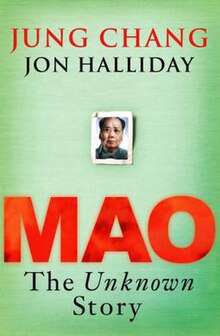 First edition cover | |
| Authors | Jung Chang Jon Halliday |
|---|---|
| Language | English |
| Subject | Mao Zedong |
| Publisher | Jonathan Cape |
Publication date | 2 June 2005 |
| Publication place | United Kingdom |
| Media type | Print (hardcover) |
| Pages | 814 |
| ISBN | 9780224071260 |
Mao: The Unknown Story is a 2005 biography of the Chinese communist leader Mao Zedong (1893–1976) that was written by the husband-and-wife team of the writer Jung Chang and the historian Jon Halliday, who detail Mao's early life, his introduction to the Chinese Communist Party, and his political career. The book summarizes Mao's transition from a rebel against the autocratic Kuomintang government to the totalitarian dictator over the People's Republic of China. Chang and Halliday heavily cover Mao's role in the planning and the execution of the Great Leap Forward and the Cultural Revolution. They open the book saying "Mao Tse-tung, who for decades held absolute power over the lives of one-quarter of the world's population, was responsible for well over 70 million deaths in peacetime, more than any other twentieth-century leader.[1]
In conducting their research for the book over the course of a decade, the authors interviewed hundreds of people who were close to Mao at some point in his life, used recently-published memoirs from Chinese political figures, and explored newly-opened archives in China and Russia. Chang had herself lived through the turmoil of the Cultural Revolution, which she described in her earlier book Wild Swans (1991).[2]
The book quickly became a best-seller in Europe and North America.[3] It received overwhelming praise from reviews in national newspapers and drew praise from some academics[4] but mostly critical or mixed by others.[5] Reviews from many China specialists were critical and cite inaccuracies and selectivity in the use of sources and the polemical portrayal of Mao.[6][7][8]
- ^ ChangHalliday (2005), p. 3.
- ^ Hayford, Charles W. (Fall 2006). "Popular History and the Scholars—Mao: The Unknown Story" (PDF). Education About Asia. 11 (2). Association for Asian Studies: 58–60. Retrieved 20 November 2021.
- ^ Fenby, Jonathan (4 December 2005). "Storm rages over bestselling book on monster Mao". The Observer. Guardian Media Group. Retrieved 20 November 2021.
- ^ Walsh, John (10 June 2005). "Mao: The Unknown Story by Jung Chang and Jon Halliday". Asian Review of Books. Archived from the original on 1 November 2005. Retrieved 20 November 2021.
- ^ Pomfret, John (11 December 2005). "Chairman Monster". The Washington Post. Retrieved 20 November 2021.
- ^ Haas, Brent (2006). "Mao: The Unknown Story". UCSD Modern Chinese History Research Site. University of California, San Diego. Retrieved 20 November 2021.
In this reviewer's opinion, and those of China specialists including Perry Link ('An Abnormal Mind,' Times Literary Supplement, 8/14/2005), Jonathan Spence ('Portrait of a Monster,' New York Review of Books, 11/3/2005), Andrew Nathan ('Jade and Plastic,' London Review of Books, 11/17/2005), Arthur Waldron, and Jeffrey Wasserstrom ('Mao as Monster,' Chicago Tribune, 11/6/2005), this is a much-needed corrective. But, excluding Waldron's laudatory review ('Mao Lives,' Commentary, 10/2005), scholarly reviewers found many problems with their research and citation methodology and blatant political axe to grind. Specifically, unhelpful citations, manipulated interpretation of sources to suit their argumentation, and blatantly-unsourced assertions mar a seminal study of Mao based on a decade of research and geared towards an important political re-evaluation of a horrible tyrant.
- ^ Benton, Gregor; Chun, Lin, eds. (2010). Was Mao Really a Monster?: The Academic Response to Chang and Halliday's "Mao: The Unknown Story" (1st ed.). Routledge. ISBN 9780415493307.
- ^ Hayford, Charles W. (June 2011). "Was Mao Really a Monster?: The Academic Response to Chang and "Halliday's Mao: The Unknown Story"". Pacific Affairs. 82 (2): 32–33. doi:10.14288/1.0045080. Retrieved 20 November 2021.